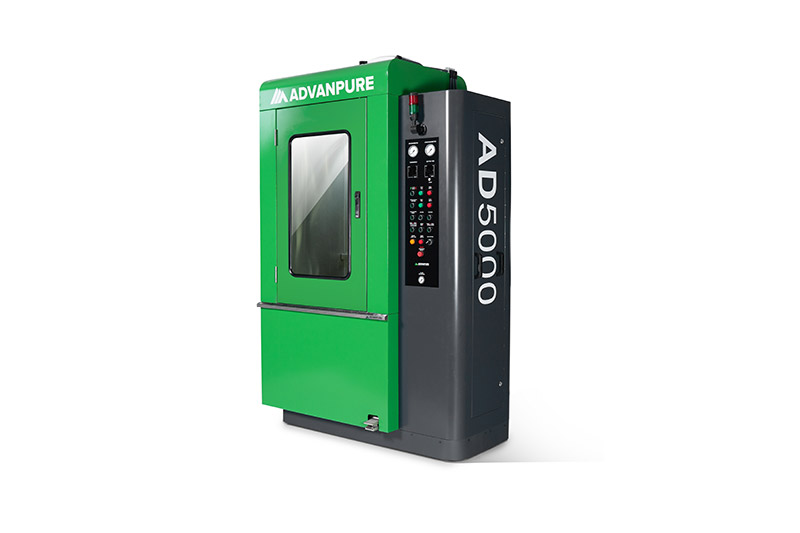
A cleaning technology specially developed for particle filter cleaning is the so-called thermodynamic cleaning process in combination with liquid cleaning. This technology guarantees the highest degree of cleaning even for extremely clogged particle filters. Continuous monitoring of the back pressure and temperature during the entire cleaning process prevents damage to the ceramic core.
Application
Cleaning process
The DPFs loaded with ash and soot are always flushed wet in a pre-cleaning process. This ensures that the flow is guaranteed and is the only way to avoid uncontrolled burning of the soot in a clogged filter. This would otherwise lead to inadmissibly high temperatures. These abrupt temperature changes, in turn, can lead to damage of the filter or the ceramic.
The cleaning process is divided into three steps.
Step 1
Before the actual cleaning, the current back pressure of the system in the uncleaned state is determined with the differential pressure measuring device AD 3000 DDS from Advanpure.
The first step in the cleaning process is the so-called liquid cleaning. Here, each filter is rinsed several times with the AD5000 or AD6000 cleaning machine.
For liquid cleaning, the filter body is exposed to water with cleaning additives.

Due to the hydraulic properties of water and the high flow forces due to the high viscosity of the liquid, more particles are detached and entrained than with pure air cleaning. With water itself and cleaning additives, the cleaning effect is improved, also because in this combination more solid ash structures are dissolved.
Before the rinse cycle, the water is heated to 70°C, which again achieves a higher cleaning effect.
During the rinsing process, the filter is completely flushed with the cleaning liquid and, in addition, manually blown through with blasts of compressed air to loosen stuck parts.
Step 2
In order for the filter to regain its original performance capacity, the remaining stuck soot particles must now be removed. The main cleaning is carried out with the AD3000 / Thermo series.
Cleaning principle of the AD3000 / Thermo
After the filter has been fixed and connected to the measuring sensors, a hot air flow specially developed and controlled for surface cleaning is applied. The exact mixing ratio is specified by programme depending on the DPF filter consistency. The entire process is continuously monitored and automatically controlled.

In the cleaning process itself, the temperatures and pressures are continuously monitored, regulated and logged in a database.
Through this controlled monitoring of temperatures and pressures, damage to the filter coating is almost impossible. The cleaning time here depends partly on the size of the filters as well as the degree of contamination still present. As a rule, it is approx. 30 – 60 min.
Cleaning takes place in a closed cycle, all substances produced during the cleaning process are collected, filtered and disposed of in an environmentally friendly manner so that no pollutants can enter the environment.
Step 3
After the particle filter cleaning process, a pressure measurement is carried out with the AD 3000DDS and then the filter is weighed. These values, as well as all filter-specific data, are also stored in a QM database.
Quality assurance and data processing

The entire workflow from the receipt of the order to the cleaning, the automated recording of the measurement data to the dispatch of the cleaned filter is mapped with a QM database specially developed for this purpose. All filter data, e.g. filter type, manufacturer, serial number, operating hours, mileage, etc. are included.
In addition to the cleaned filter, the customer receives a cleaning protocol with all relevant data.
Advantages
- Shortest cleaning time (70 – 120 minutes)
- “no cutting”, no design change
- No intermediate cleaning required
- Equal filter maintenance intervals
- Cleaning for all DPF and SCR systems
Disadvantages
- Cleaning process is fairly complex
Conclusion
The thermodynamic cleaning process in conjunction with liquid cleaning can be described as the best and most effective method currently available on the cleaning market for exhaust aftertreatment systems. The costs for cleaning are in the range of the other cleaning methods.
Any questions?
We answer many questions in our FAQ on the subject of particle filter cleaning.
We will show you more DPF cleaning methods in the following articles:
(PART 1) DPF CLEANING WITH CHEMICALS
(PART 2) DPF CLEANING WITH COMPRESSED AIR
(PART 3) DPF CLEANING WITH OVEN
(PART 4, this article) THERMODYNAMIC CLEANING IN COMBINATION WITH LIQUID CLEANING…


